Relationship between organizational culture and firm performance: A case study in Viet Nam
Organizational culture plays a crucial role in an organization’s daily operations as it is considered
one of the key factors for stability and competitive advantage. Further, it can offer numerous
advantages, such as cooperation, control, communication, and commitment [12]. Although
culture is often conceived as intangible, difficult to understand, there has been significant
research in the literature to explore the impact of organizational culture on firm performance [7,
9, 19, 20]. Most of the research has applied Denison’s organizational model, and this model
includes four dimensions, namely mission, involvement, adaptability, and consistency. This is
because each of the four major cultural traits in Denison’s model promotes superior firm
performance [19], its integrative nature, as well as its emphasis on both internal and external
factors [20]. However, the majority of existing studies on organizational culture and performance
have concentrated in developed countries. In Vietnam, there has been little research to explore
this relationship [8, 16]. A few prior studies are carried out in a specific area, e.g., project
management or a specific province, which can lead to the limitation in generalization. Therefore,
this study aims to explore the relationship between organizational culture and firm performance
in the context of Vietnam.
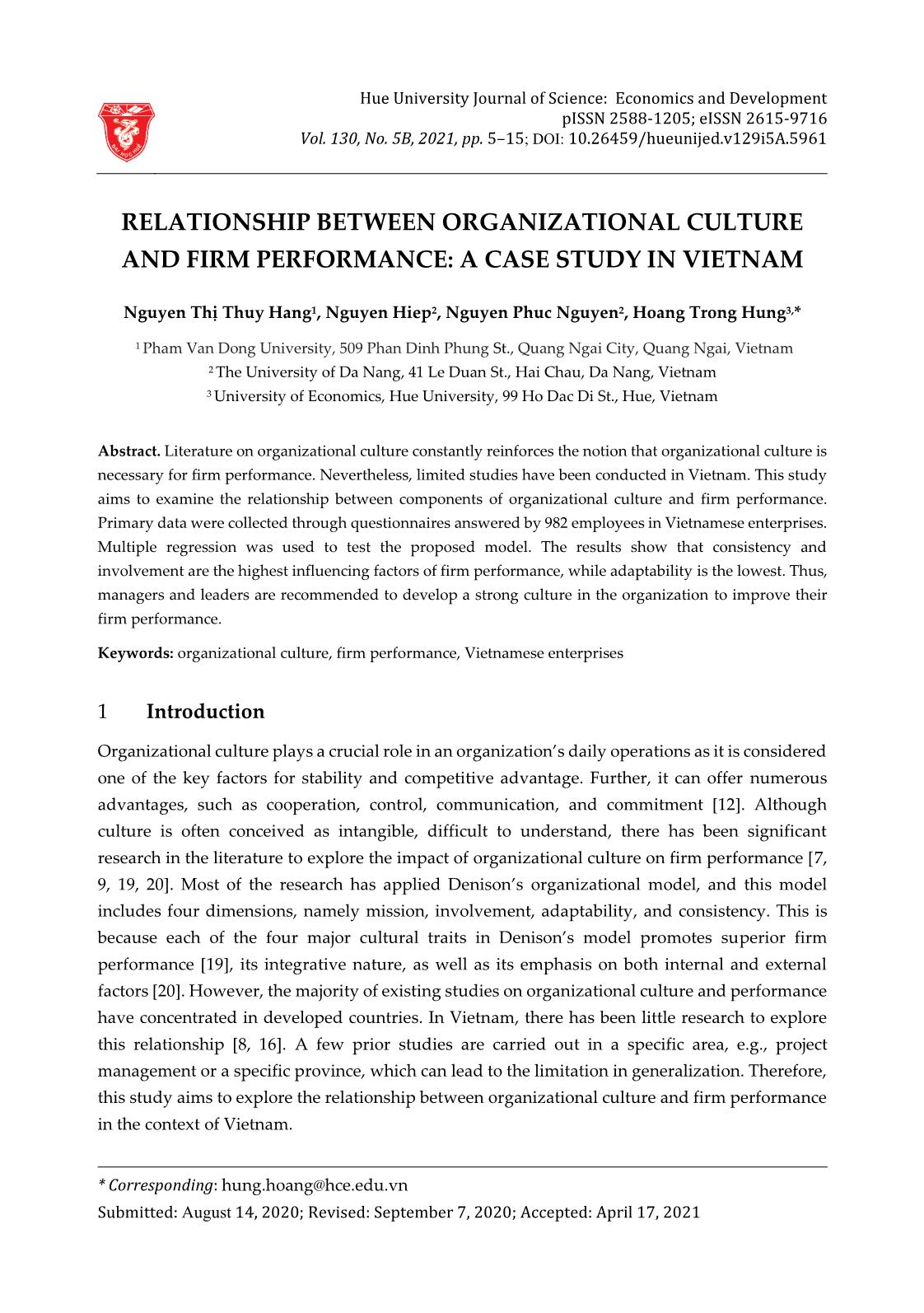
Trang 1
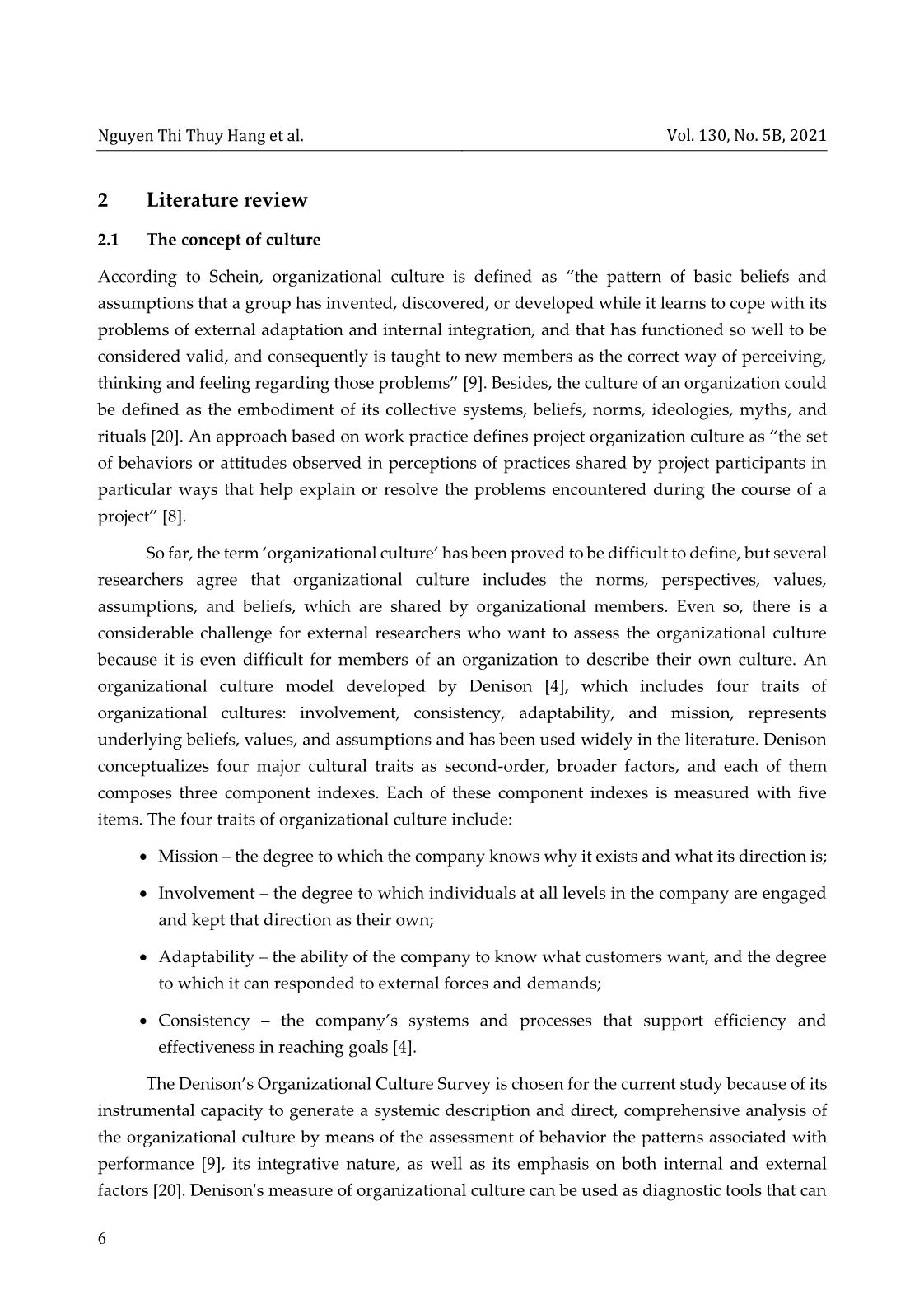
Trang 2
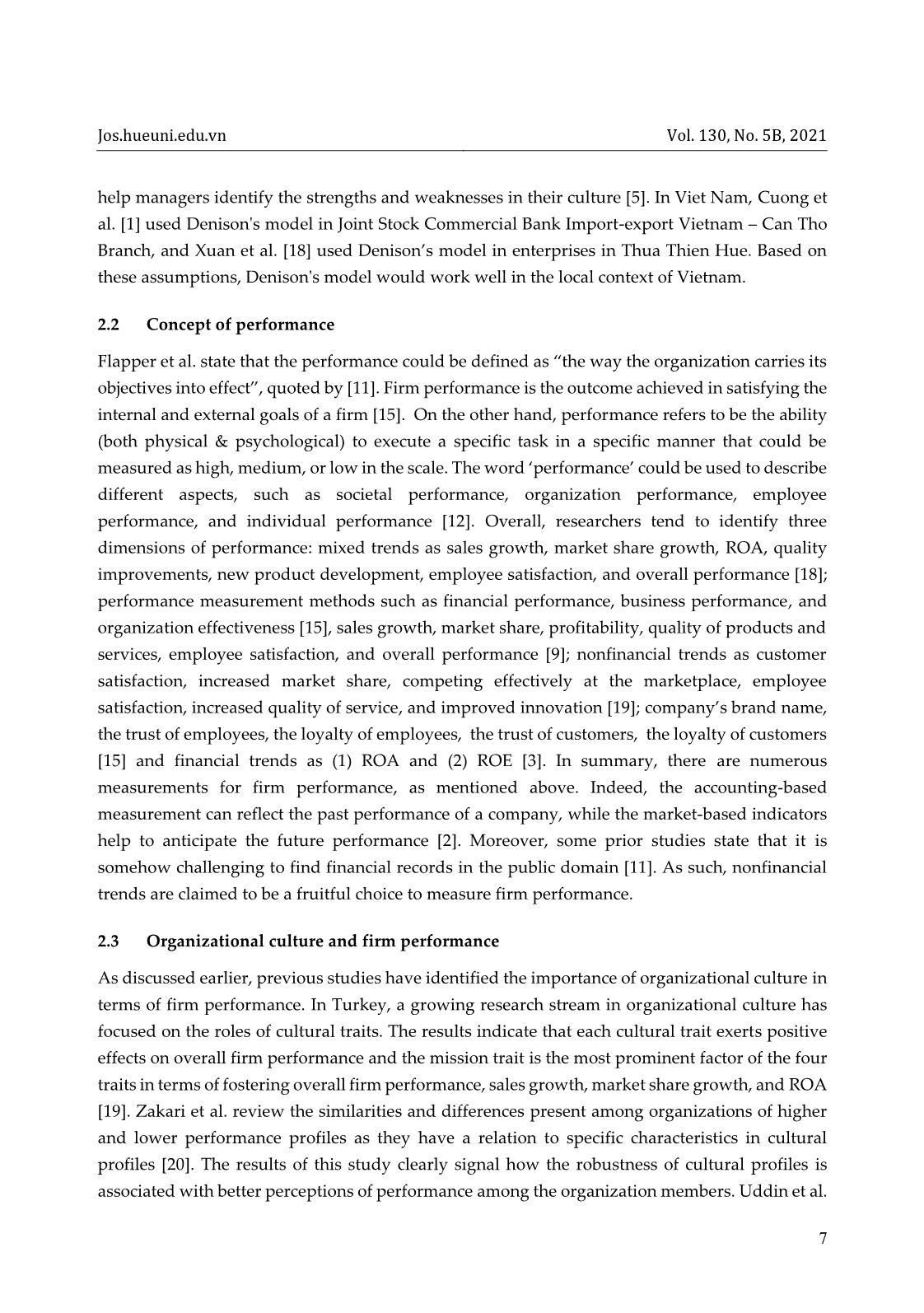
Trang 3
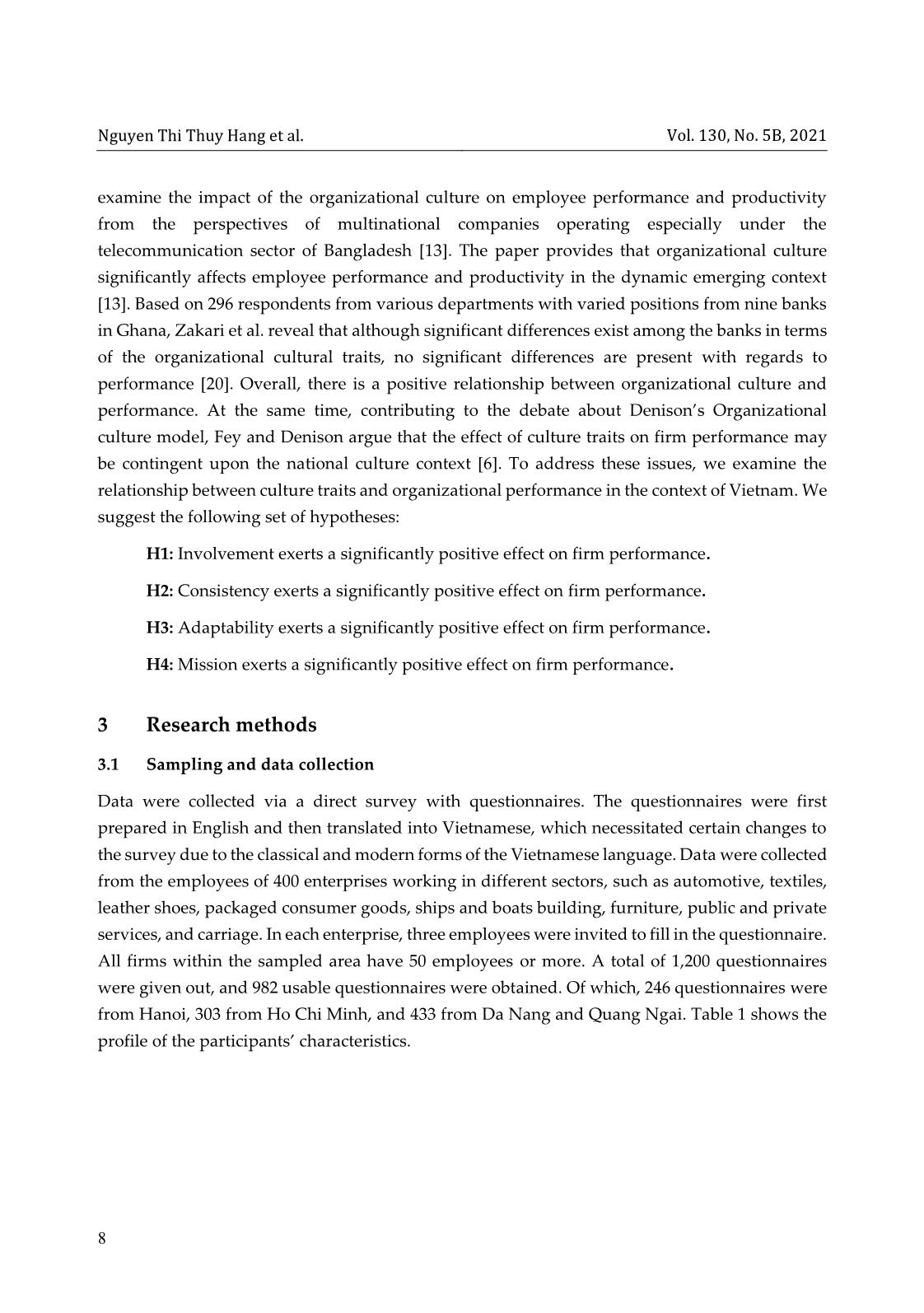
Trang 4
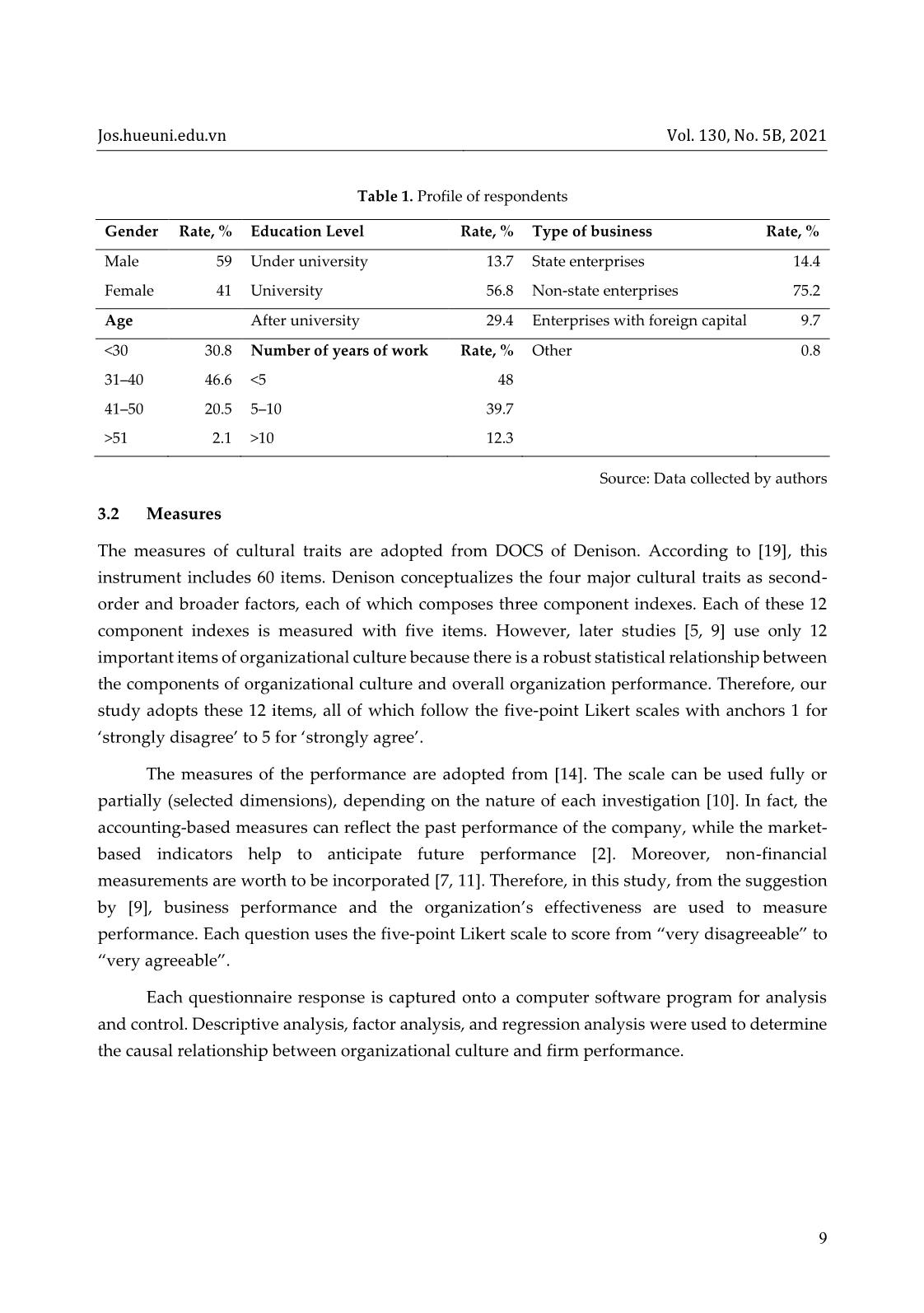
Trang 5
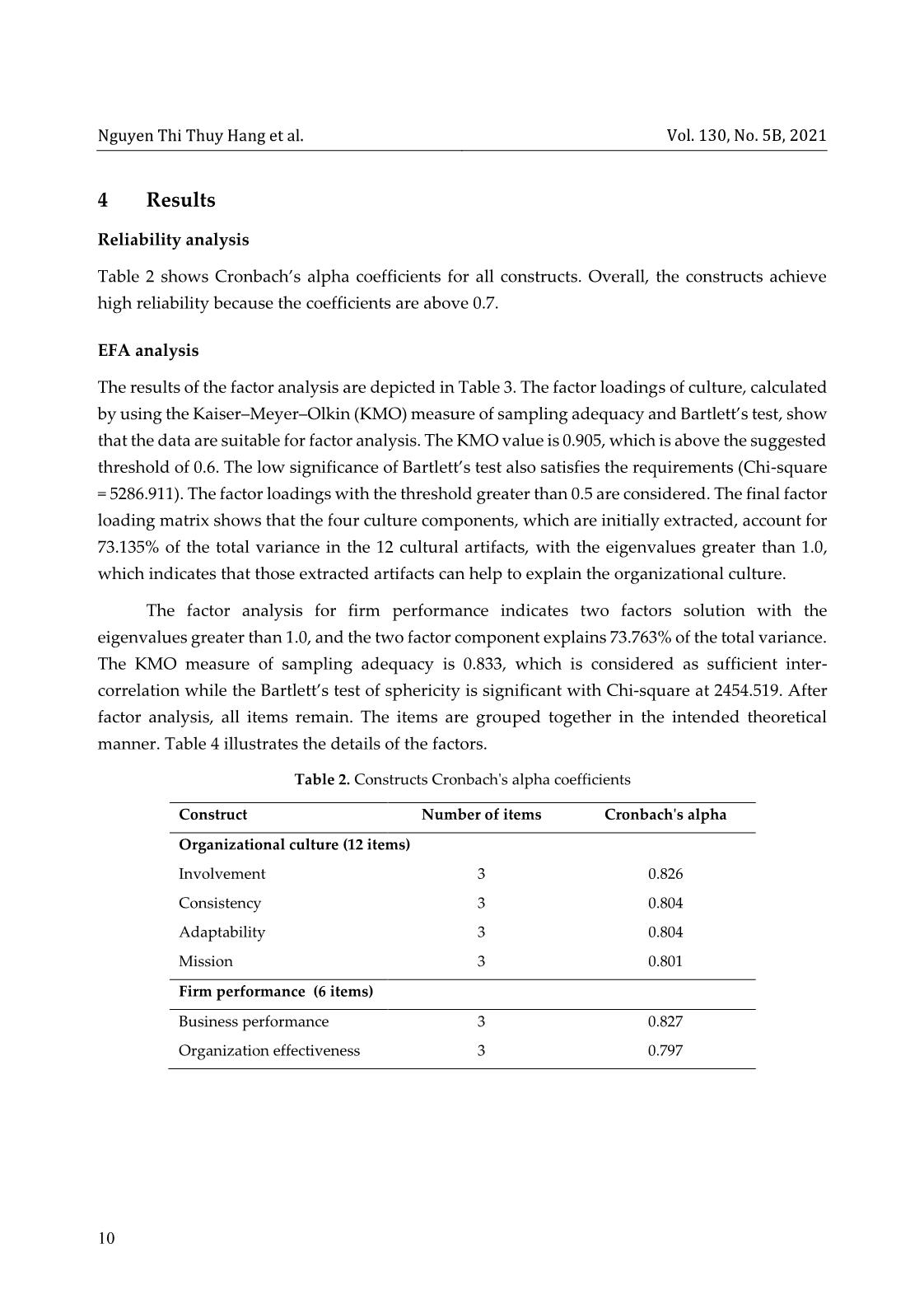
Trang 6
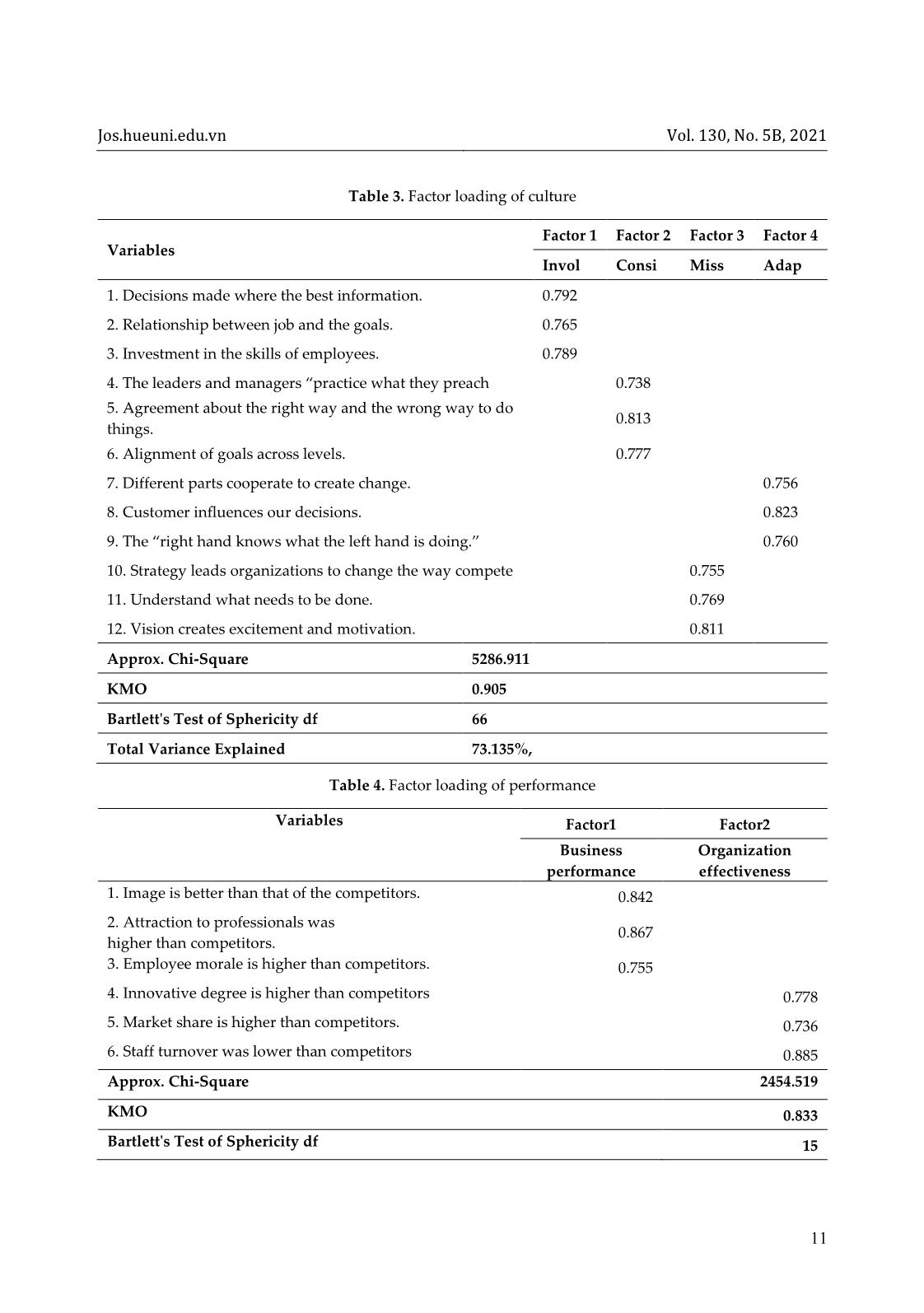
Trang 7
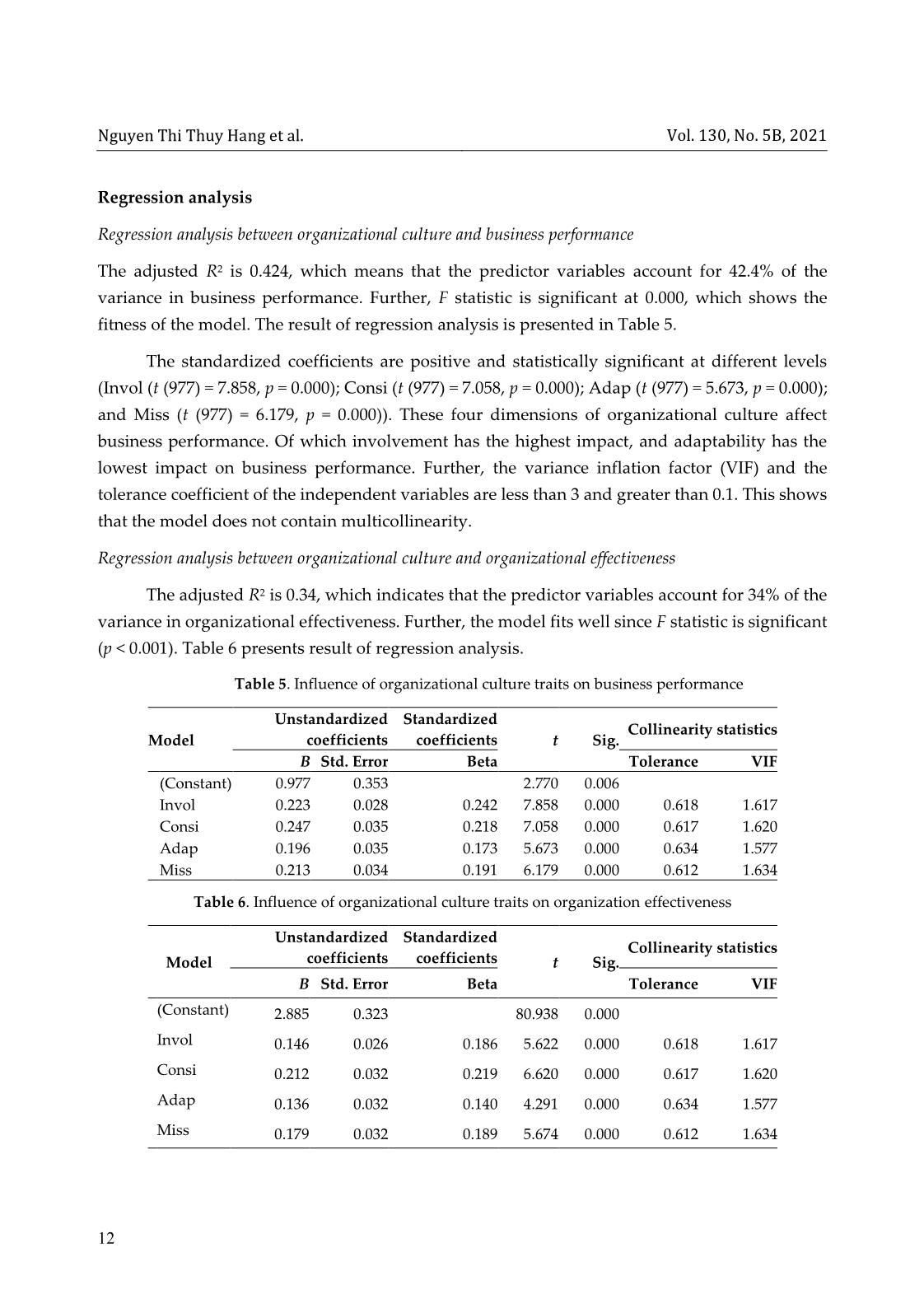
Trang 8
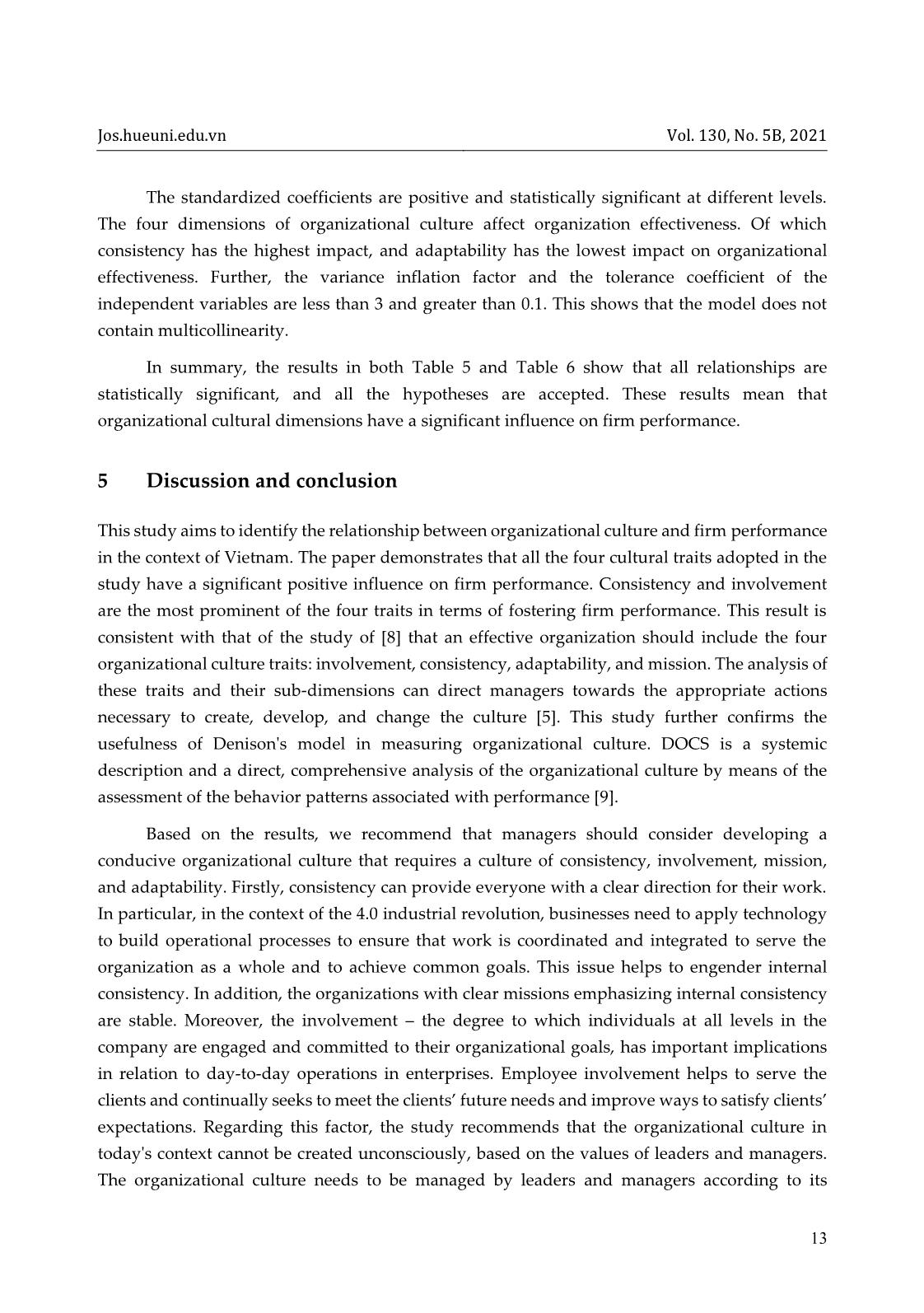
Trang 9
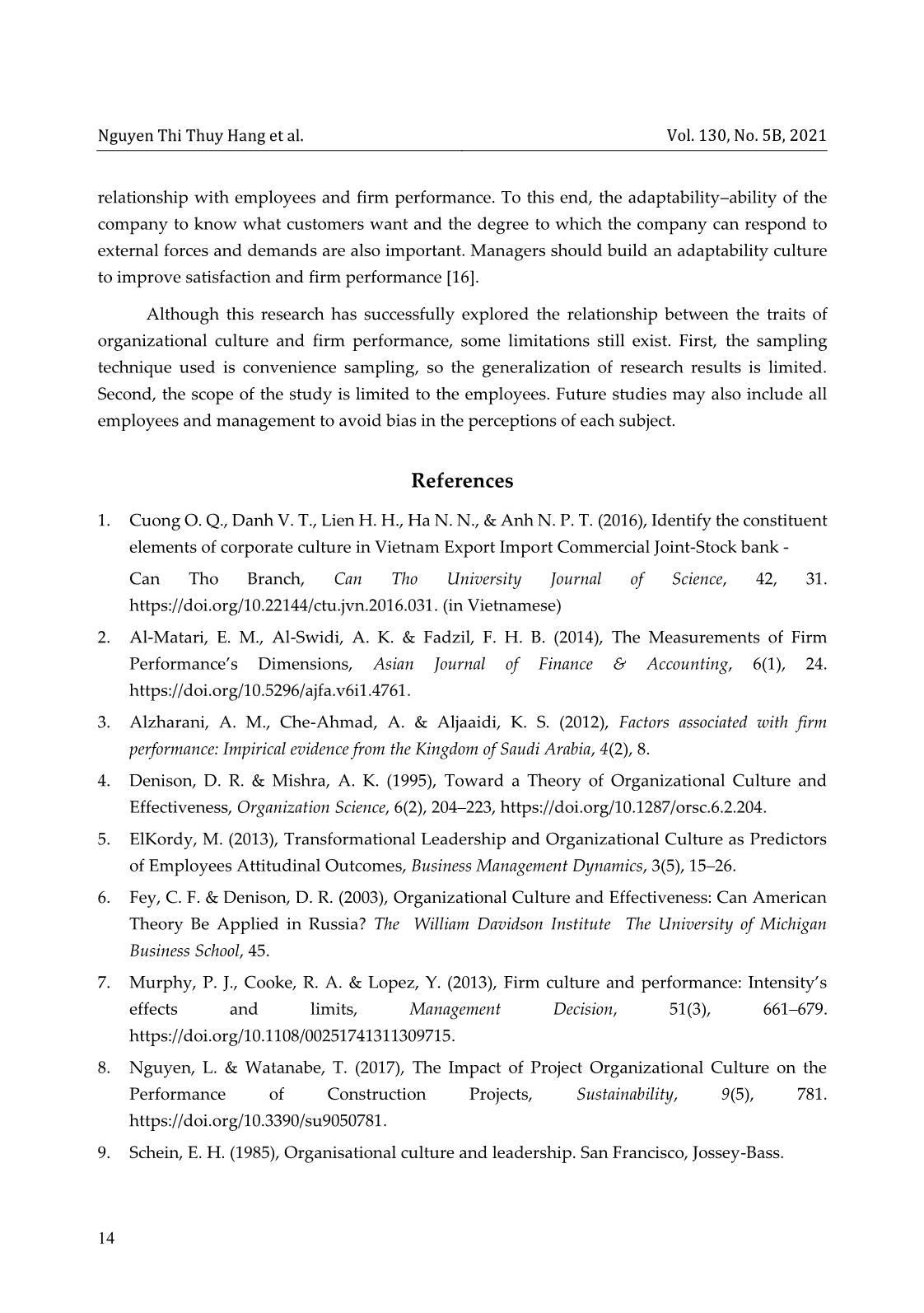
Trang 10
Tải về để xem bản đầy đủ
Tóm tắt nội dung tài liệu: Relationship between organizational culture and firm performance: A case study in Viet Nam
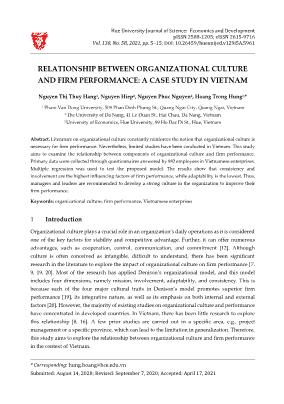
Hue University Journal of Science: Economics and Development pISSN 2588-1205; eISSN 2615-9716 Vol. 130, No. 5B, 2021, pp. 5–15; DOI: 10.26459/hueunijed.v129i5A.5961 * Corresponding: hung.hoang@hce.edu.vn Submitted: August 14, 2020; Revised: September 7, 2020; Accepted: April 17, 2021 RELATIONSHIP BETWEEN ORGANIZATIONAL CULTURE AND FIRM PERFORMANCE: A CASE STUDY IN VIETNAM Nguyen Thị Thuy Hang1, Nguyen Hiep2, Nguyen Phuc Nguyen2, Hoang Trong Hung3,* 1 Pham Van Dong University, 509 Phan Dinh Phung St., Quang Ngai City, Quang Ngai, Vietnam 2 The University of Da Nang, 41 Le Duan St., Hai Chau, Da Nang, Vietnam 3 University of Economics, Hue University, 99 Ho Dac Di St., Hue, Vietnam Abstract. Literature on organizational culture constantly reinforces the notion that organizational culture is necessary for firm performance. Nevertheless, limited studies have been conducted in Vietnam. This study aims to examine the relationship between components of organizational culture and firm performance. Primary data were collected through questionnaires answered by 982 employees in Vietnamese enterprises. Multiple regression was used to test the proposed model. The results show that consistency and involvement are the highest influencing factors of firm performance, while adaptability is the lowest. Thus, managers and leaders are recommended to develop a strong culture in the organization to improve their firm performance. Keywords: organizational culture, firm performance, Vietnamese enterprises 1 Introduction Organizational culture plays a crucial role in an organization’s daily operations as it is considered one of the key factors for stability and competitive advantage. Further, it can offer numerous advantages, such as cooperation, control, communication, and commitment [12]. Although culture is often conceived as intangible, difficult to understand, there has been significant research in the literature to explore the impact of organizational culture on firm performance [7, 9, 19, 20]. Most of the research has applied Denison’s organizational model, and this model includes four dimensions, namely mission, involvement, adaptability, and consistency. This is because each of the four major cultural traits in Denison’s model promotes superior firm performance [19], its integrative nature, as well as its emphasis on both internal and external factors [20]. However, the majority of existing studies on organizational culture and performance have concentrated in developed countries. In Vietnam, there has been little research to explore this relationship [8, 16]. A few prior studies are carried out in a specific area, e.g., project management or a specific province, which can lead to the limitation in generalization. Therefore, this study aims to explore the relationship between organizational culture and firm performance in the context of Vietnam. Nguyen Thi Thuy Hang et al. Vol. 130, No. 5B, 2021 6 2 Literature review 2.1 The concept of culture According to Schein, organizational culture is defined as “the pattern of basic beliefs and assumptions that a group has invented, discovered, or developed while it learns to cope with its problems of external adaptation and internal integration, and that has functioned so well to be considered valid, and consequently is taught to new members as the correct way of perceiving, thinking and feeling regarding those problems” [9]. Besides, the culture of an organization could be defined as the embodiment of its collective systems, beliefs, norms, ideologies, myths, and rituals [20]. An approach based on work practice defines project organization culture as “the set of behaviors or attitudes observed in perceptions of practices shared by project participants in particular ways that help explain or resolve the problems encountered during the course of a project” [8]. So far, the term ‘organizational culture’ has been proved to be difficult to define, but several researchers agree that organizational culture includes the norms, perspectives, values, assumptions, and beliefs, which are shared by organizational members. Even so, there is a considerable challenge for external researchers who want to assess the organizational culture because it is even difficult for members of an organization to describe their own culture. An organizational culture model developed by Denison [4], which includes four traits of organizational cultures: involvement, consistency, adaptability, and mission, represents underlying beliefs, values, and assumptions and has been used widely in the literature. Denison conceptualizes four major cultural traits as second-order, broader factors, and each of them composes three component indexes. Each of these component indexes is measured with five items. The four traits of organizational culture include: • Mission – the degree to which the company know ... of the performance are adopted from [14]. The scale can be used fully or partially (selected dimensions), depending on the nature of each investigation [10]. In fact, the accounting-based measures can reflect the past performance of the company, while the market- based indicators help to anticipate future performance [2]. Moreover, non-financial measurements are worth to be incorporated [7, 11]. Therefore, in this study, from the suggestion by [9], business performance and the organization’s effectiveness are used to measure performance. Each question uses the five-point Likert scale to score from “very disagreeable” to “very agreeable”. Each questionnaire response is captured onto a computer software program for analysis and control. Descriptive analysis, factor analysis, and regression analysis were used to determine the causal relationship between organizational culture and firm performance. Nguyen Thi Thuy Hang et al. Vol. 130, No. 5B, 2021 10 4 Results Reliability analysis Table 2 shows Cronbach’s alpha coefficients for all constructs. Overall, the constructs achieve high reliability because the coefficients are above 0.7. EFA analysis The results of the factor analysis are depicted in Table 3. The factor loadings of culture, calculated by using the Kaiser–Meyer–Olkin (KMO) measure of sampling adequacy and Bartlett’s test, show that the data are suitable for factor analysis. The KMO value is 0.905, which is above the suggested threshold of 0.6. The low significance of Bartlett’s test also satisfies the requirements (Chi-square = 5286.911). The factor loadings with the threshold greater than 0.5 are considered. The final factor loading matrix shows that the four culture components, which are initially extracted, account for 73.135% of the total variance in the 12 cultural artifacts, with the eigenvalues greater than 1.0, which indicates that those extracted artifacts can help to explain the organizational culture. The factor analysis for firm performance indicates two factors solution with the eigenvalues greater than 1.0, and the two factor component explains 73.763% of the total variance. The KMO measure of sampling adequacy is 0.833, which is considered as sufficient inter- correlation while the Bartlett’s test of sphericity is significant with Chi-square at 2454.519. After factor analysis, all items remain. The items are grouped together in the intended theoretical manner. Table 4 illustrates the details of the factors. Table 2. Constructs Cronbach's alpha coefficients Construct Number of items Cronbach's alpha Organizational culture (12 items) Involvement 3 0.826 Consistency 3 0.804 Adaptability 3 0.804 Mission 3 0.801 Firm performance (6 items) Business performance 3 0.827 Organization effectiveness 3 0.797 Jos.hueuni.edu.vn Vol. 130, No. 5B, 2021 11 Table 3. Factor loading of culture Variables Factor 1 Factor 2 Factor 3 Factor 4 Invol Consi Miss Adap 1. Decisions made where the best information. 0.792 2. Relationship between job and the goals. 0.765 3. Investment in the skills of employees. 0.789 4. The leaders and managers “practice what they preach 0.738 5. Agreement about the right way and the wrong way to do things. 0.813 6. Alignment of goals across levels. 0.777 7. Different parts cooperate to create change. 0.756 8. Customer influences our decisions. 0.823 9. The “right hand knows what the left hand is doing.” 0.760 10. Strategy leads organizations to change the way compete 0.755 11. Understand what needs to be done. 0.769 12. Vision creates excitement and motivation. 0.811 Approx. Chi-Square 5286.911 KMO 0.905 Bartlett's Test of Sphericity df 66 Total Variance Explained 73.135%, Table 4. Factor loading of performance Variables Factor1 Factor2 Business performance Organization effectiveness 1. Image is better than that of the competitors. 0.842 2. Attraction to professionals was higher than competitors. 0.867 3. Employee morale is higher than competitors. 0.755 4. Innovative degree is higher than competitors 0.778 5. Market share is higher than competitors. 0.736 6. Staff turnover was lower than competitors 0.885 Approx. Chi-Square 2454.519 KMO 0.833 Bartlett's Test of Sphericity df 15 Nguyen Thi Thuy Hang et al. Vol. 130, No. 5B, 2021 12 Regression analysis Regression analysis between organizational culture and business performance The adjusted R2 is 0.424, which means that the predictor variables account for 42.4% of the variance in business performance. Further, F statistic is significant at 0.000, which shows the fitness of the model. The result of regression analysis is presented in Table 5. The standardized coefficients are positive and statistically significant at different levels (Invol (t (977) = 7.858, p = 0.000); Consi (t (977) = 7.058, p = 0.000); Adap (t (977) = 5.673, p = 0.000); and Miss (t (977) = 6.179, p = 0.000)). These four dimensions of organizational culture affect business performance. Of which involvement has the highest impact, and adaptability has the lowest impact on business performance. Further, the variance inflation factor (VIF) and the tolerance coefficient of the independent variables are less than 3 and greater than 0.1. This shows that the model does not contain multicollinearity. Regression analysis between organizational culture and organizational effectiveness The adjusted R2 is 0.34, which indicates that the predictor variables account for 34% of the variance in organizational effectiveness. Further, the model fits well since F statistic is significant (p < 0.001). Table 6 presents result of regression analysis. Table 5. Influence of organizational culture traits on business performance Model Unstandardized coefficients Standardized coefficients t Sig. Collinearity statistics B Std. Error Beta Tolerance VIF (Constant) 0.977 0.353 2.770 0.006 Invol 0.223 0.028 0.242 7.858 0.000 0.618 1.617 Consi 0.247 0.035 0.218 7.058 0.000 0.617 1.620 Adap 0.196 0.035 0.173 5.673 0.000 0.634 1.577 Miss 0.213 0.034 0.191 6.179 0.000 0.612 1.634 Table 6. Influence of organizational culture traits on organization effectiveness Model Unstandardized coefficients Standardized coefficients t Sig. Collinearity statistics B Std. Error Beta Tolerance VIF (Constant) 2.885 0.323 80.938 0.000 Invol 0.146 0.026 0.186 5.622 0.000 0.618 1.617 Consi 0.212 0.032 0.219 6.620 0.000 0.617 1.620 Adap 0.136 0.032 0.140 4.291 0.000 0.634 1.577 Miss 0.179 0.032 0.189 5.674 0.000 0.612 1.634 Jos.hueuni.edu.vn Vol. 130, No. 5B, 2021 13 The standardized coefficients are positive and statistically significant at different levels. The four dimensions of organizational culture affect organization effectiveness. Of which consistency has the highest impact, and adaptability has the lowest impact on organizational effectiveness. Further, the variance inflation factor and the tolerance coefficient of the independent variables are less than 3 and greater than 0.1. This shows that the model does not contain multicollinearity. In summary, the results in both Table 5 and Table 6 show that all relationships are statistically significant, and all the hypotheses are accepted. These results mean that organizational cultural dimensions have a significant influence on firm performance. 5 Discussion and conclusion This study aims to identify the relationship between organizational culture and firm performance in the context of Vietnam. The paper demonstrates that all the four cultural traits adopted in the study have a significant positive influence on firm performance. Consistency and involvement are the most prominent of the four traits in terms of fostering firm performance. This result is consistent with that of the study of [8] that an effective organization should include the four organizational culture traits: involvement, consistency, adaptability, and mission. The analysis of these traits and their sub-dimensions can direct managers towards the appropriate actions necessary to create, develop, and change the culture [5]. This study further confirms the usefulness of Denison's model in measuring organizational culture. DOCS is a systemic description and a direct, comprehensive analysis of the organizational culture by means of the assessment of the behavior patterns associated with performance [9]. Based on the results, we recommend that managers should consider developing a conducive organizational culture that requires a culture of consistency, involvement, mission, and adaptability. Firstly, consistency can provide everyone with a clear direction for their work. In particular, in the context of the 4.0 industrial revolution, businesses need to apply technology to build operational processes to ensure that work is coordinated and integrated to serve the organization as a whole and to achieve common goals. This issue helps to engender internal consistency. In addition, the organizations with clear missions emphasizing internal consistency are stable. Moreover, the involvement – the degree to which individuals at all levels in the company are engaged and committed to their organizational goals, has important implications in relation to day-to-day operations in enterprises. Employee involvement helps to serve the clients and continually seeks to meet the clients’ future needs and improve ways to satisfy clients’ expectations. Regarding this factor, the study recommends that the organizational culture in today's context cannot be created unconsciously, based on the values of leaders and managers. The organizational culture needs to be managed by leaders and managers according to its Nguyen Thi Thuy Hang et al. Vol. 130, No. 5B, 2021 14 relationship with employees and firm performance. To this end, the adaptability–ability of the company to know what customers want and the degree to which the company can respond to external forces and demands are also important. Managers should build an adaptability culture to improve satisfaction and firm performance [16]. Although this research has successfully explored the relationship between the traits of organizational culture and firm performance, some limitations still exist. First, the sampling technique used is convenience sampling, so the generalization of research results is limited. Second, the scope of the study is limited to the employees. Future studies may also include all employees and management to avoid bias in the perceptions of each subject. References 1. Cuong O. Q., Danh V. T., Lien H. H., Ha N. N., & Anh N. P. T. (2016), Identify the constituent elements of corporate culture in Vietnam Export Import Commercial Joint-Stock bank - Can Tho Branch, Can Tho University Journal of Science, 42, 31. https://doi.org/10.22144/ctu.jvn.2016.031. (in Vietnamese) 2. Al-Matari, E. M., Al-Swidi, A. K. & Fadzil, F. H. B. (2014), The Measurements of Firm Performance’s Dimensions, Asian Journal of Finance & Accounting, 6(1), 24. https://doi.org/10.5296/ajfa.v6i1.4761. 3. Alzharani, A. M., Che-Ahmad, A. & Aljaaidi, K. S. (2012), Factors associated with firm performance: Impirical evidence from the Kingdom of Saudi Arabia, 4(2), 8. 4. Denison, D. R. & Mishra, A. K. (1995), Toward a Theory of Organizational Culture and Effectiveness, Organization Science, 6(2), 204–223, https://doi.org/10.1287/orsc.6.2.204. 5. ElKordy, M. (2013), Transformational Leadership and Organizational Culture as Predictors of Employees Attitudinal Outcomes, Business Management Dynamics, 3(5), 15–26. 6. Fey, C. F. & Denison, D. R. (2003), Organizational Culture and Effectiveness: Can American Theory Be Applied in Russia? The William Davidson Institute The University of Michigan Business School, 45. 7. Murphy, P. J., Cooke, R. A. & Lopez, Y. (2013), Firm culture and performance: Intensity’s effects and limits, Management Decision, 51(3), 661–679. https://doi.org/10.1108/00251741311309715. 8. Nguyen, L. & Watanabe, T. (2017), The Impact of Project Organizational Culture on the Performance of Construction Projects, Sustainability, 9(5), 781. https://doi.org/10.3390/su9050781. 9. Schein, E. H. (1985), Organisational culture and leadership. San Francisco, Jossey-Bass. Jos.hueuni.edu.vn Vol. 130, No. 5B, 2021 15 10. Santos, J. B. & Brito, L. A. L. (2012), Toward a subjective measurement model for firm performance, BAR - Brazilian Administration Review, 9(spe), 95–117. https://doi.org/10.1590/S1807-76922012000500007. 11. Sosiawani, I., Ramli, A. B., Mustafa, M. B. & Yusoff, R. Z. B. (2015), Strategic Planning and Firm Performance: A Proposed Framework, 7. 12. Sun, S. (2008), Organizational Culture and Its Themes, International Journal of Business and Management, 3(12), 137–141. 13. Uddin, M. J., Luva, R. H. & Hossain, S. M. M. (2012), Impact of Organizational Culture on Employee Performance and Productivity: A Case Study of Telecommunication Sector in Bangladesh, International Journal of Business and Management, 8(2), https://doi.org/10.5539/ijbm.v8n2p63. 14. Venkatraman, N. & Vasudevan Ramanujam (1986), Measurement of business economic performance: An examination of method convergence, The Academy of Management Review, 11(4), 42. 15. Wei, L., Jun Liu & Neil C. Herndon. (2011), SHRM and product innovation: Testing the moderating effects of organizational culture and structure in Chinese firms, The International Journal of Human Resource Management, 22(1), 19–33. 16. Vo Thi Quy (2018), Organizational Culture and Firm Performance – A Comparative Study between Local and Foreign Companies Located in Ho Chi Minh City, International Journal of Scientific Research and Innovative Technology, 5(2), 45–53. 17. Wang, F.-J., Chich-Jen, S. & Mei-Ling, T. (2010), Effect of leadership style on organizational performance as viewed from human resource management strategy, African Journal of Business Management, 4(18), 3924–3936. 18. Truong Thi Huong Xuan, Nguyen Dang Hao, Nguyen Tai Phuc (2019), Organizational culture of enterprises in Thua Thien Hue province with Denison model, Hue University Journal of Science: Economics and Development, 128(5C), 45–54. 19. Yilmaz, C. & Ergun, E. (2008), Organizational culture and firm effectiveness: An examination of relative effects of culture traits and the balanced culture hypothesis in an emerging economy, Journal of World Business, 43(3), 290–306. https://doi.org/10.1016/j.jwb.2008.03.019. 20. Zakari, M., Poku, K. & Owusu-Ansah, W. (2013), Organizational Culture and Organisational Performance: Empirical Evidence from the Banking Industry in Ghana, International Journal of Business, Humanity and Technology, 3(1), 13.
File đính kèm:
 relationship_between_organizational_culture_and_firm_perform.pdf
relationship_between_organizational_culture_and_firm_perform.pdf

